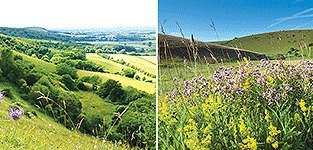Sussex Wildlife Trust: Yellow Meadow Ants: South Downs Skyscrapers.
August 30th, 2020 Ant hills are mini miracles of design and construction, the visible tip of the ant’s underground empire.
Ant hills are mini miracles of design and construction, the visible tip of the ant’s underground empire.If you’re feeling boxed-in by buildings and overwhelmed by architecture, I’ve found the perfect escape route. Head up onto the South Downs and let the developed world be stripped away with every step. Yet here, in this ancient landscape, towering above the thyme and trefoils in the turf, you’ll find some of the most impressive buildings in Sussex.
Ant hills are mini miracles of design and construction, the visible tip of the ant’s underground empire. Soil is mined and carried, grain by grain, to the surface to construct this metropolis of mounds some of which can be centuries old. Every ant hill represents a separate colony of Yellow Meadow Ants – respected as the finest architects amongst Britain’s 42 ant species.
Ant hills are high-rise heat-traps built to harvest the sun’s warmth. This soil solarium houses a series of chambers; the colony’s nursery. Here, worker ants tenderly tend to eggs, pupae and larvae – moving them around within the ant hill to keep them always on the sunny side.
With a strong division of labour, each colony is a ‘superorganism’ made of thousands of hard-working individuals serving a common cause – their colony and queen. But life is far from peaceful. Every ant hill is a miniature kingdom at war with its neighbouring ant hills. Epic battles are fought daily on these downs, and every summer squadrons of winged ants take to the skies in an attempt to establish new colonies. It’s a perilous mission – certain death awaits them if they land in occupied territory.
Down under the ant hill, other ants work on the aphid farm. Root-feeding aphids are herded and ‘milked’ for their honeydew – a hi-energy drink which helps fuel the colony.
Ants also obtain a similar sugary syrup from the caterpillars of Chalk Hill Blue butterflies. When these caterpillars are ready to pupate they are carried underground and adopted by the ant colony. Upon emergence, the subterranean homesick blue butterflies scramble back to the surface and escape to the summer skies.
Ant hills don’t just benefit ants; their angles and aspects create a unique micro-habitat on chalk downland. Their sun-baked slopes are great for basking butterflies, grasshoppers and lizards and their soft, sifted soil is loved by mosses, grasses and flowers. This softness is also their vulnerability. Every ant lives in fear of the great winged terror from the sky – the green woodpecker. Its brutal bill and sticky harpoon tongue can cause carnage in a colony.
Winged monsters, kingdoms at war – it’s a veritable Game of Thrones out there on the South Downs in September.
By Michael Blencowe: Learning & Engagement Officer, Sussex Wildlife Trust
Sussex Wildlife Trust is an independent registered charity caring for wildlife and habitats throughout Sussex. Founded in 1961, we rely on the support of our members to help protect our rich natural heritage. Please consider supporting our work. As a member you will be invited to join Michael Blencowe on our regular wildlife walks and also enjoy free events, discounts on wildlife courses, Wildlife magazine and our guide book: Discovering Wildlife in Sussex. It’s easy to join online at:
www.sussexwildlifetrust.org.uk/join or T: 01273 497532.
Yellow Meadow Ant (c) Paul Richards Sussex Wildlife Trust
Ant hills are mini miracles of design and construction, the visible tip of the ant’s underground empire. Soil is mined and carried, grain by grain, to the surface to construct this metropolis of mounds some of which can be centuries old. Every ant hill represents a separate colony of Yellow Meadow Ants – respected as the finest architects amongst Britain’s 42 ant species.
Ant hills are high-rise heat-traps built to harvest the sun’s warmth. This soil solarium houses a series of chambers; the colony’s nursery. Here, worker ants tenderly tend to eggs, pupae and larvae – moving them around within the ant hill to keep them always on the sunny side.
With a strong division of labour, each colony is a ‘superorganism’ made of thousands of hard-working individuals serving a common cause – their colony and queen. But life is far from peaceful. Every ant hill is a miniature kingdom at war with its neighbouring ant hills. Epic battles are fought daily on these downs, and every summer squadrons of winged ants take to the skies in an attempt to establish new colonies. It’s a perilous mission – certain death awaits them if they land in occupied territory.
Down under the ant hill, other ants work on the aphid farm. Root-feeding aphids are herded and ‘milked’ for their honeydew – a hi-energy drink which helps fuel the colony.
Ants also obtain a similar sugary syrup from the caterpillars of Chalk Hill Blue butterflies. When these caterpillars are ready to pupate they are carried underground and adopted by the ant colony. Upon emergence, the subterranean homesick blue butterflies scramble back to the surface and escape to the summer skies.
Ant hills don’t just benefit ants; their angles and aspects create a unique micro-habitat on chalk downland. Their sun-baked slopes are great for basking butterflies, grasshoppers and lizards and their soft, sifted soil is loved by mosses, grasses and flowers. This softness is also their vulnerability. Every ant lives in fear of the great winged terror from the sky – the green woodpecker. Its brutal bill and sticky harpoon tongue can cause carnage in a colony.
Winged monsters, kingdoms at war – it’s a veritable Game of Thrones out there on the South Downs in September.
By Michael Blencowe: Learning & Engagement Officer, Sussex Wildlife Trust
Sussex Wildlife Trust is an independent registered charity caring for wildlife and habitats throughout Sussex. Founded in 1961, we rely on the support of our members to help protect our rich natural heritage. Please consider supporting our work. As a member you will be invited to join Michael Blencowe on our regular wildlife walks and also enjoy free events, discounts on wildlife courses, Wildlife magazine and our guide book: Discovering Wildlife in Sussex. It’s easy to join online at:
www.sussexwildlifetrust.org.uk/join or T: 01273 497532.
Yellow Meadow Ant (c) Paul Richards Sussex Wildlife Trust
Comments (0)
No comments have been submitted yet.Why not be the first to send us your thoughts
Leave A Comment
Thank you for your comments, they will appear shortly once approved.
Recent Posts
Have You Seen...






